Aloe vera: what does it look like, how to transplant and properly care?

The aloe vera plant has long been known for its medicinal properties, and therefore is very popular. It is unique in that it can be grown at home. How to do this, what you need to know about the rules of care, what a flower looks like, this article will tell you.
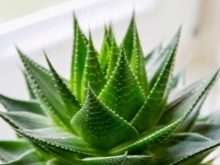
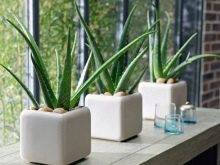
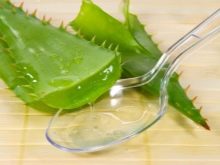
What it is?
In general, the name of the flower from the Latin language translates as "true aloe". The plant has other names, it is also a medicinal plant, Indian, Barbados, real aloe, Lanza, Barbdensis. Its homeland is considered to be Central Africa, although it is now growing in different countries of the world. Today it is considered to be a houseplant, although it is also cultivated as an outdoor plant.
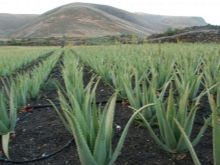
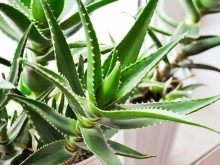
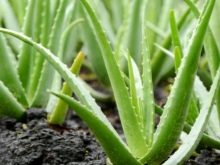
Description
Aloe vera is a medicinal plant that can survive in adverse conditions. It belongs to the category of succulents, the Asphodel family. The difference between this species is the weak development of the root system. The aerial portion consists of long leaves with a spiny edge on either side of each leaf.
The shape of the leaves is elongated and looks more like thick, curved stems. Moreover, each leaf, which has a dark green hue, is saturated with juice, which makes it fleshy. The sap of the plant has a gel-like texture and a faint greenish-yellow color. In height, the peduncle can reach 70-80 cm.
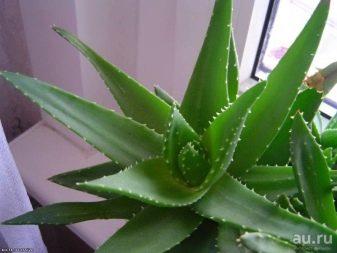
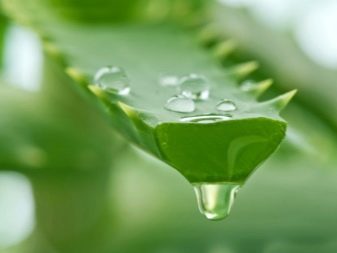
Aloe vera flowers are often collected in an inflorescence, their color can be yellowish or red. The second tone is less common in nature. Flowering Barbadensis Miller indoors is more rare than when grown outdoors. If at home it blooms once every 10 years, then in natural conditions it happens once every 2 years.
Aloe vera is one of the most popular types of aloe, it is among the 500 varieties of the flower. It grows as a bush, has leaves tending upward. Its difference from other types is the possibility of using it inside. As for the gradation of subspecies, then aloe vera does not have them.
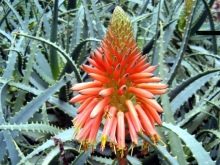
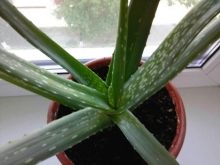
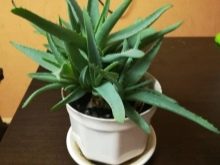
Landing
It is necessary to start flower reproduction at the very beginning of spring. It is during this period that the plant begins to move away from winter sleep. Therefore, vital processes begin to be activated in it, which have a beneficial effect on the development of roots. Right now it is ready to adapt to new conditions.
To plant a plant, a container is selected. The plant is unpretentious to the container, but it is preferable to choose a ceramic pot for growing succulents. A clay analogue will not work, since such a product will absorb all the moisture from the soil into itself. When the container is prepared, a high drainage layer is poured into it. It is necessary in order to exclude stagnation of moisture.

A few pebbles can be left to secure the aloe, because over time it can fall to the side under the weight of its weight. After the drainage layer is placed in the pot, it is filled with soil. To help the succulent take root faster, the soil can be purchased at a specialty store, choosing the option for growing aloe. If this is not available, the mixture is prepared independently.
For this, coarse sand, humus, expanded clay gravel, perlite and deciduous soil are mixed. The components are taken in identical proportions and placed on the drainage layer. First, a layer of mixed soil is poured over the pebbles, after which sand is added. Peat is not used for planting aloe vera. After preparing the soil, the plant is planted.
It is necessary to take ripe seeds for planting, planting them in prepared containers. When the sprouts germinate and get stronger, they can be transplanted into other containers, and with an identical soil composition.
More than one plant should not grow in one container, as it will need more soil as it develops. To make the soil with planted aloe nutritious and loose, you can add charcoal or brick chips to it.
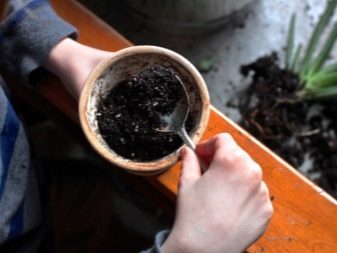
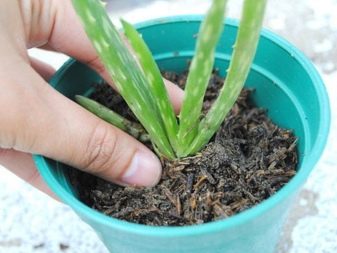
Care
Despite the fact that the plant is considered unpretentious to care for, you can take note of several recommendations. This will make it easier to cultivate your succulent at home and will allow you to grow a healthy plant.
- For the proper development and growth of aloe vera, sunlight is needed, and therefore the flower pot after germination must be placed in a sunny place.
- In the summer, the pot must be taken outside, allowing the succulent to be saturated with fresh air.
- If aloe is grown in room conditions, it is necessary to provide it with a temperature regime with the most favorable conditions for development, which is achieved at a temperature of + 22 ... + 25 degrees.
- The minimum temperature mark at which the plant will grow in winter is at least +12 degrees.
- Watering the plant in summer should be combined with spraying so that the flower has enough moisture.
- Watering aloe vera in winter should be dosed, and the amount of moisture should be less compared to summer watering.
- We must not forget about mineral and organic fertilizers. Top dressing should be done no more than once a month in summer.
- A succulent grown at home must be protected from the cold in the winter season. You cannot open a window with a flower on the windowsill.
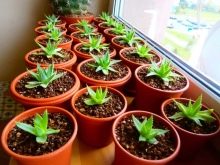
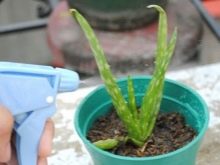
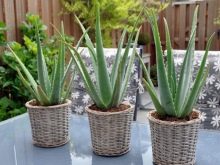
Watering a plant has its own characteristics. For example, overfilling aloe vera with water can cause its leaves to wilt and turn pale. Moreover, the abundance of water will cause rotting of the root system and stem. If only such signs are outlined, the plant must be immediately removed from the pot and transplanted to a new place with dry soil. In this case, it is important to carefully examine the roots and stem: everything that has rotted must be removed.
You can not water the plant in the heat, and even during the day. From this it can die. We must not forget about watering, it must be timely and regular. While the plant is small, it is sprayed more often, because the drying out of the trunk will lead to its death. As you leave, you will have to remove dust from the leaves by wiping them with a damp cloth.
It is impossible to start aloe, because it reacts to the untimely care. In general, all the rules are basic and not complicated: optimal temperature, light, watering, feeding. Removing the leaves for treatment does not harm him, after the separation of the children or transplanting, he needs time to root. Growing in the dark, aloe may not bloom at all.
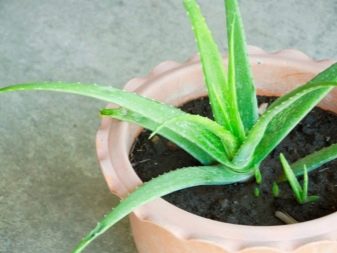
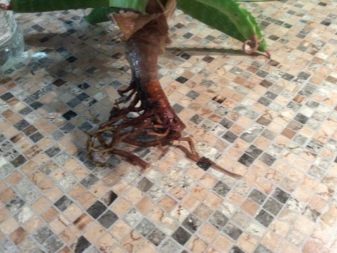
Reproduction
Aloe vera can be propagated in different ways: by cuttings, seeds, shoots, children. Consider the techniques used by gardeners.
Children
If the option using children or root shoots is chosen as the basis, it is worth considering that this method is more durable in comparison with other breeding methods. However, it is also the most effective, for which it is in demand among flower growers. This type of reproduction consists in performing several sequential steps:
- select children with a developed root system that is capable of developing independently;
- water the container with a flower abundantly to make it easier to take out the children;
- using a pointed garden spatula, the babies are separated from the mother plant;
- the separated root shoots are placed in a previously prepared container with water for further root development;
- two weeks later, the new plant is ready for transplanting, you need to take the shoot and place it in a separate pot with moistened soil.
When propagating a plant by root shoots, it is important to consider that the container for the succulent must have sufficient volume for the development of the root system.If suddenly part of the layering is damaged during cutting, you cannot plant it immediately. You need to wait at least 3-4 days until the break dries up a little.
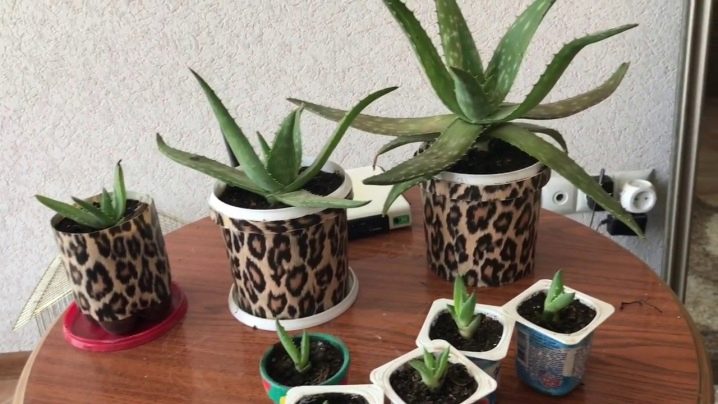
Seeds
To increase the germination of seeds, you need to take for reproduction the freshest of them that have ripened this year. In order to prevent various diseases, seeds prepared for planting should be soaked in a weak solution of valerian. Next, prepare the container and substrate. The container must be chosen flat, the soil must be wet, but not flooded with water.
To increase the chances of correct flower development, the soil can be prepared by treating it with a weak solution of potassium permanganate. The seeds are deepened into the ground by about 1-2 cm, while maintaining a distance of 2 cm between them, which is necessary for the comfortable growth of seedlings. After planting the seeds, it is necessary to create a greenhouse effect, for which the container is covered with plastic wrap or ordinary glass.
It is undesirable at this time to put the container in a dark place, since the seedlings will immediately stretch upward in search of sunlight. As soon as all the shoots appear, which usually takes a week, the film is removed. If the house is too dry, it can be used to cover the container at night for the first time so that the seedlings do not dry out. When they get stronger, the film is not needed, and it will be possible to spray aloe like an adult plant.
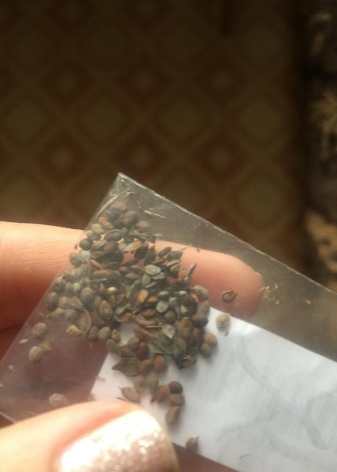

Propagating aloe using this method is laborious: then you will have to transplant the sprouts into a separate container with identical soil, and after a year, plant the strengthened plant in an individual pot. If the soil from the site is clayey and heavy, it must be mixed with a special substrate by purchasing it at a flower store.
By leaf or cuttings
In order to plant a succulent with a rootless leaf, a good leaf must be chosen with great care. You need to choose not so much the biggest one as the healthy one, since this will be the decisive factor in its high-quality and rapid development. However, it is not necessary to choose healthy leaves of the smallest size in order to avoid degeneration of the culture. This method is complicated in that the moisture contained in the leaves can cause the plant to rot, which, in turn, reduces the chances of reproduction.
To root a leaf or a stalk and propagate aloe vera, you must adhere to a number of rules. For example, you cannot immediately cut off the cuttings or leaves and stick them into the ground. You need to wait until they are slightly pulled up, getting rid of excess moisture. Only after that it will be possible to deepen them into the substrate, not forgetting to strengthen them with a support (for example, by tying them to a small branch).
Some gardeners process leaf cuts with crushed activated carbon, keep the cuttings for a day and only then root them in the ground. In this case, it is important not to overmoisten the plant, and therefore it is not necessary to water it for the first time, but you can create a greenhouse effect. Someone uses ash to process the cut, wrapping a sheet or cutting in thin paper and putting it in the refrigerator for 24 hours.


Other growers, after cutting off good leaves, wait until a protective film appears at the cut site. According to this reproduction technique, the leaf after cutting must be removed in a dark place for a week, or even two. Before planting, you can process not only the cut, but also the container itself. For example, it can be washed with water and laundry soap.
A sheet is placed in the prepared substrate, deepening it by about one-fifth of its entire length. In this case, the soil must be moistened, but not too wet, otherwise the leaf will rot. Now you can wait for rooting, remembering to spray the plant as needed. After the leaf is rooted, the frequency of watering can be reduced.
Someone propagates aloe by cuttings, lowering them into water with a depth of 2 cm for the formation of roots, or they are placed in wet sand for germination. At the same time, they try to use apical cuttings or leaves.When choosing a cutting, the number of leaves is monitored: there should be at least 4-6 of them.
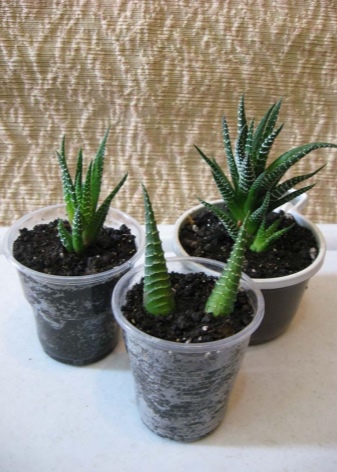
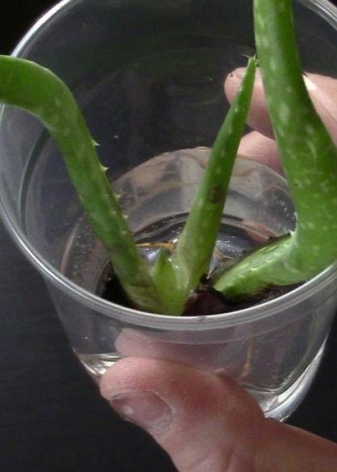
Transfer
Over time, the plant can become cramped in the pot. This can be one of the reasons for its death, because over time, the removal of nutrients by the root system of the plant from the soil will occur. And even the constant application of fertilizers will not save the matter: it will not be possible to avoid transplanting, because over time the humic and enzyme components will disappear from the soil, which cannot be replenished in any way. The first signs of this will be the lightness of the soil and its crusting of the irrigation field.
As for young plants, they must be replanted every year, changing the soil. When aloe vera is 5 years old, you can shorten the frequency. Now it will be enough for him to change the soil and capacity every 2-3 years. You need to do a transplant in the spring or summer period of the year: this is the best time for the plant to take root quickly.
For the drainage layer, you can use river pebbles, small shells, and clay shards. According to the norms for the container, the new pot should be about a quarter larger than the previous one.
You cannot buy cramped dishes, since this slows down the growth and development of the succulent, the lower leaves dry. The roots should not touch the edges of the pot, without reaching about 4 cm.

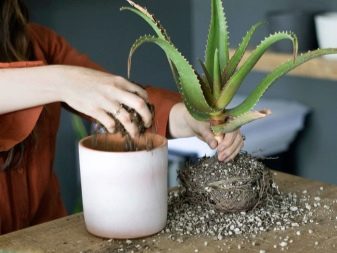
To transplant aloe according to all the rules, you need to take into account the recommendations of specialists.
- Before transplanting, the soil in a flower pot must be watered and loosened. This will ensure less traumatic removal of the roots along with the earth ball.
- The drainage layer in the new container should be at least one fifth of the total height of the pot. The minimum layer is on average 10 cm.
- To extract the plant, the pot is placed on its side, the flower is taken out along with a lump of earth, without pulling out anything.
- The roots are removed from the excess substrate, then the aloe is placed in a new pot and sprinkled with soil.
- You can bury the plant in the soil at the same level of the root collar as in the old pot.
- It is necessary to water in such a way that the soil can stick to the roots. The remaining soil is filled up and slightly compacted.
- From above, the soil is supplemented with a layer of expanded clay or pebbles (coarse sand).
- The pot is removed to a shaded place and not watered for a couple of days. At this time, the transplanted succulent should not be sprayed.
- After rooting, the flower is placed in a sunny place and monitored for timely watering.
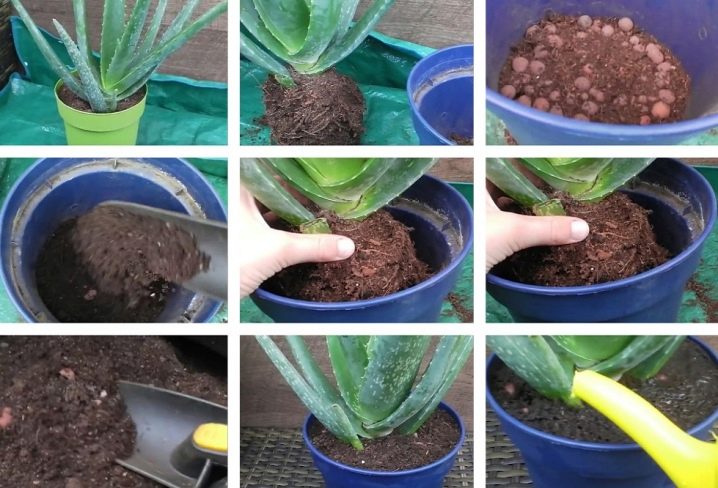
Possible problems
In the process of development and growth of aloe vera, the layman may encounter some problems. Let's note the main ones.
- If, during the growth of the plant, the ends of the leaves become brownish, this indicates insufficient air humidity. In this case, you just need to ventilate the room where the flower grows more often.

- When a plant is elongated in growth, this indicates insufficient illumination of the place where it is located. If the windows of the apartment face the north side, you can provide the flower with additional (artificial) lighting by means of special phytolamps.
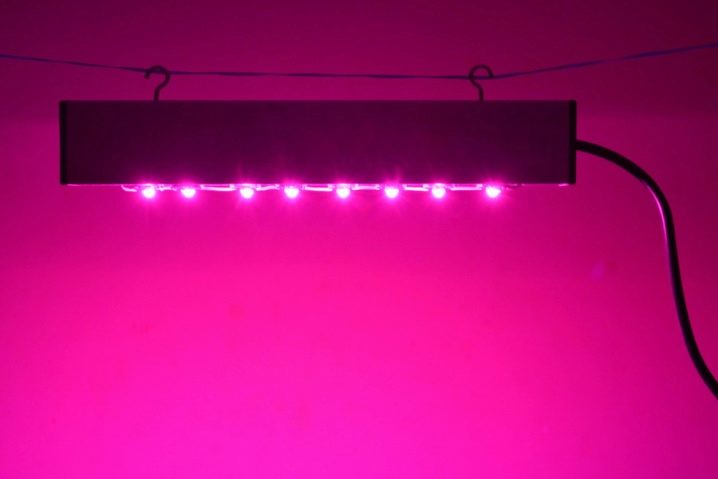
- If dark brown spots began to appear on the leaves from above, this indicates a lesion of the plant with a scutellum. Here you must first remove the pests with a cloth soaked in alcohol. After that, the succulent is treated with an insecticide.

- Sometimes the flower is attacked by a spider mite, which is also removed with a chemical. Prevention of its appearance will be frequent airing of the room.
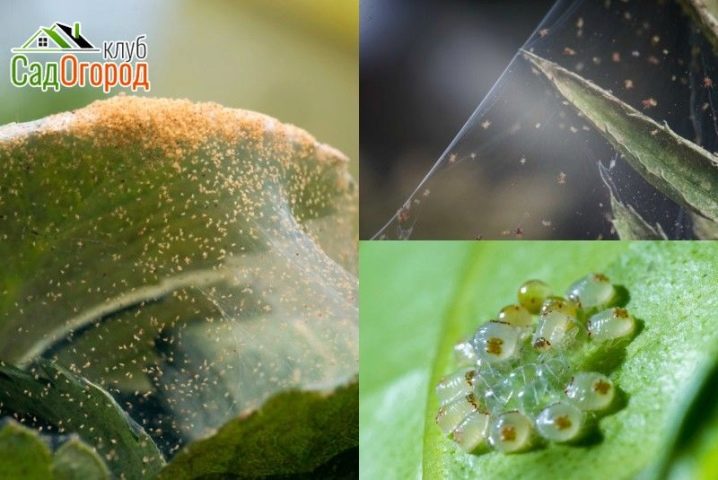
- If suddenly the plant dries up (the lower and then the upper leaves dry), this indicates its defeat by dry rot. In this case, it will not be possible to save aloe vera, this disease manifests itself almost imperceptibly and fleetingly. To prevent this, you must initially follow all the rules of planting and leaving.
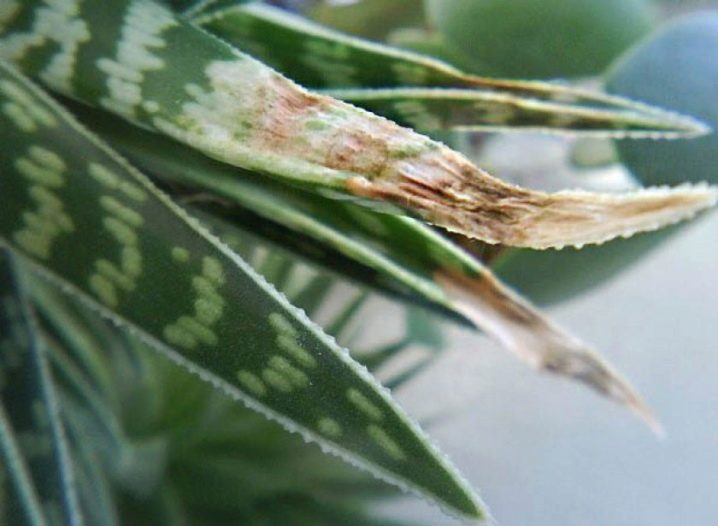
- Blooming at home is less common, and therefore you can often take out aloe outside in summer. If you create too sparing conditions for development for it, it will weaken, and you may never see the flowers.
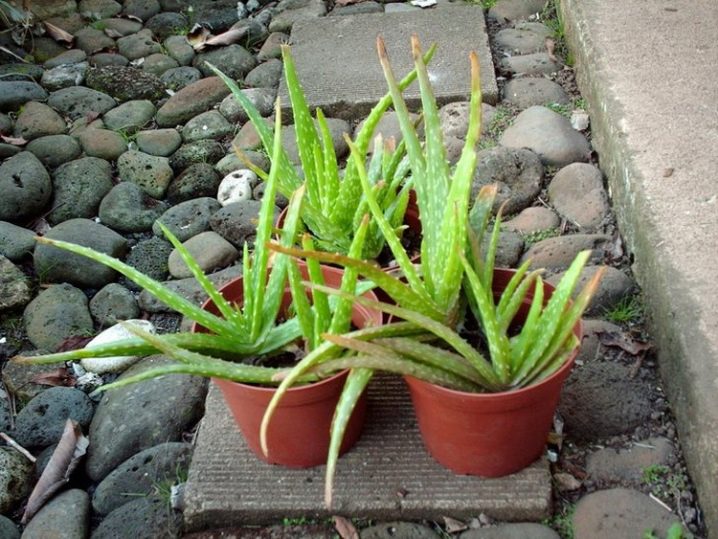
In order to notice the succulent disease in time, you need to examine it: any change in the color of the leaves or their condition indicates a developmental disorder. Delaying for later can be detrimental to plant health.
It is not watered from time to time: you need to care for and water in a timely manner, as well as monitor the condition of the soil and the leaves themselves.
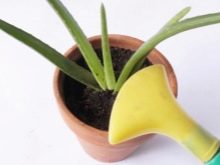
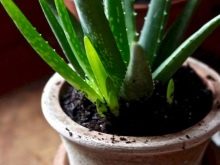
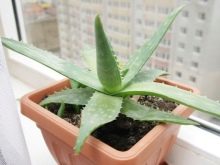
For information on how to grow aloe vera at home, see the next video.























































The comment was sent successfully.